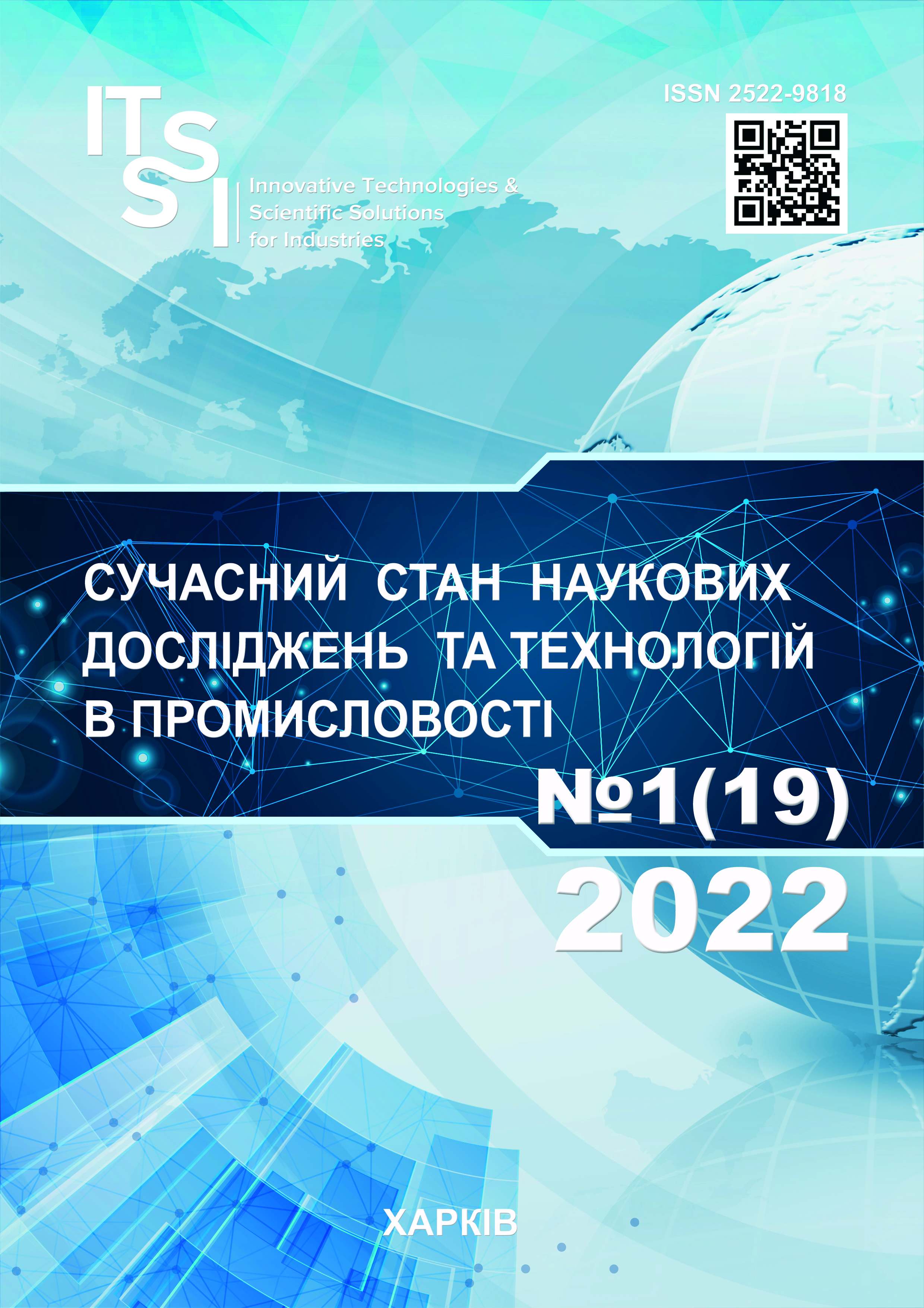ESTIMATION OF SOFTWARE COMPLEXITY OF CALCULATION OF AUTOREGRESSION COEFFICIENTS AT DIGITAL SPECTRAL ANALYSIS
DOI:
https://doi.org/10.30837/ITSSI.2022.19.085Keywords:
spectral analysis;, autoregression;, Levinson;, Durbin;, Trench algorithms;, computational complexity;, computer arithmetic;, microcontrollersAbstract
The subject of research in the article are algorithms for fast calculation of autoregression coefficients in digital spectral analysis and estimation of the number of arithmetic operations required for their implementation. The aim of the article – comparative analysis of the speed of different algorithms for calculating the coefficients of autoregression as part of the algorithms of spectral analysis, including analysis of the complexity of their microcontroller implementation. Tasks to be solved: selection of spectral analysis methods suitable for diagnostics of technological equipment, analysis of methods for calculating autoregression coefficients and derivation of relations for estimating software complexity of algorithms and calculation of numerical estimates of addition and multiplication for some algorithms, adaptation of developed methods and estimates to microcontrollers. spectrum Applied methods: algorithm theory, Fourier transform, natural series, microcontroller programming. The results obtained: it is shown that spectral estimation methods based on Yul-Walker equations, which require the calculation of autoaggression coefficients, combine sufficient resolution and resistance to interference with acceptable implementation complexity. Estimates of the number of additions and multiplications for the Levinson, Durbin, and Trench algorithms are obtained, and their comparative analysis is performed. The calculation times for microcontroller arithmetic with fixed and floating points were count upon. Conclusions: When constructing spectrum analyzers for the diagnosis of technological equipment, it is advisable to use the Yul-Walker method. A comparison of Levinson, Durbin, and Trench algorithms for calculating autoregression coefficients showed that the Trench method requires a minimum number of additions, and the Durbin method requires a minimum number of multiplications. At microcontroller realization of spectrum analyzers, it is necessary to consider features of the arithmetic used by the controller. The Trench method is the fastest in the case of floating-point arithmetic and small-scale modeling. In other cases, Durbin's method is more effective.
References
Shmelov, Y. M., Vladov, S. I., Kryshan, O. F., Gvozdik, S. D., Chyzhova, L. I. (2018), "Research of classification method of TV3-117 engine rating perations based on neural network technologies", ["Rozrobka metodu klasyfikatsii rezhymiv roboty aviatsiinoho dvyhuna TV3-117 na osnovi neiromerezhevykh tekhnolohii"], Innovative Technologies and Scientific Solutions for Industries, No. 4, P. 93–102. DOI: https://doi.org/10.30837/2522-9818.2018.6.093
Raskin, L., Sukhomlyn, L., Ivanchikhin, Y., Korsun R. (2021), "Method of identification of object states according to the results of fuzzy measurements of controlled parameters", ["Metod identyfikatsii staniv obiektu za rezultatamy nechitkykh vymiriuvan kontroliuvanykh parametriv"], Innovative Technologies and Scientific Solutions for Industries, No. 4 (18), P. 75–86. DOI: https://doi.org/10.30837/ITSSI.2021.18.075
Follum, J., Becejac, T., Etingov, P. A. (2021 ), "Robust Yule-Walker Method for Online Monitoring of Power System Electromechanical Modes of Oscillation", 2021 IEEE Power & Energy Society Innovative Smart Grid Technologies Conference (ISGT). DOI: https://doi.org/10.1109/ISGT49243.2021.9372152
TMForum (2021), "Application Framework (TAM)", available at: https://www.tmforum.org/application-framework (last accessed 15.12.2021).
TMForum (2021), "Information Framework (SID)", available at: https://www.tmforum.org/information-framework-sid. (last accessed 15.12.2021).
TMForum (2021), "Open Digital Architecture (ODA)", available at: https://www.tmforum.org/oda/ (last accessed 15.12.2021).
Goel, S. (2020), "The journey from CSP to DSP. Informa PLC", available at: https://telecoms.com/opinion/the-journey-from-csp-to-dsp/ (last accessed 15.12.2021).
Torosyan, E. K., Shekhovtsova, E. I., Akopyan, A. A. (2019), "Analysis of end-to-end methods for the basic architecture of telecom operator systems automation" ["Analiz metodov skvoznoy avtomatizatsii bazovoy arkhitektury sistem operatora svyazi"], Petersburg economic journal , No. 2., P. 172–177.
Newman, M. (2020), "FUTURE BSS. Say goodbye to software customization", available at: https://inform.tmforum.org/research-reports/future-bss-say-goodbye-to-software-customization/ (last accessed 15.12.2021).
TMForum (2020), "Cloud native OSS/BSS", available at: https://inform.tmforum.org/research-reports/cloud-native-oss-bss/ (last accessed 15.12.2021).
IIDA (2015), "A Guide to the Business Analysis Body of Knowledge (BABOK Guide)", IIBA, Р. 512.
Wiegers, K. I., Bitti, J. (2019), "Software Requirements (Developer Best Practices) 3rd Edition" ["Razrabotka trebovaniy k programmnomu obespecheniyu. 3-e izdanie, dopolnennoe"], BHV, Spb., Р. 736.
Mortensen, M. H., Offredo-Zreik, L. (2020), "Microservices-Based Cloud Native Modernization of OSS/BSS with Open Source. Informa PLC", available at: https://telecoms.com/intelligence/microservices-based- cloud-native-modernization-of-oss-bss-with-open-source/ (last accessed 15.12.2021).
McElligott, T. (2019), "Future OSS. Toward an Open Digital Architecture. TMForum", available at: https://inform.tmforum.org/research-reports/future-oss-towards-an-open-digital-architecture/ (last accessed 15.12.2021).
Smidovych, L.S., Kalmykov, A.V. (2010), "Perspective directions for the development of business processes automation technologies" ["Perspektivnye napravleniya razvitiya tekhnologiy avtomatizatsii biznes-protsessov"], Radioelectronic and Computer Systems, Vol. 4 (45), P. 75–81.
Turkington, I. (2021), "Open Digital Framework, Open Digital Architecture. ITU-T". Virtual forum on The Role of Standards in Accelerating Digital Transformation for Cities and Communities, Р. 42.
Andersen, L (2021), "Designing lasting simplification into a BSS contract. TMForum", available at: https://inform.tmforum.org/digital-transformation-and-maturity/2021/08/designing-lasting-simplification-into-a-bss-contract/ (last accessed 15.12.2021).
Newman, M. (2021), "Next generation BSS: the Telefónica way. TM Forum", available from: https://inform.tmforum.org/research-reports/next-generation-bss-operator-and-vendor-perspectives (last accessed 15.12.2021).
Fedorovich, O.Ye., Babich, A.V. (2016), "Optimization of multilevel component architecture software system" [“Optimizatsiya mnogourovnevoy komponentnoy arkhitektury programmnoy sistemy”], Information Processing Systems, 2016. Vol. 1 (75), Р. 175–177.
Downloads
Published
How to Cite
Issue
Section
License

This work is licensed under a Creative Commons Attribution-NonCommercial-ShareAlike 4.0 International License.
Our journal abides by the Creative Commons copyright rights and permissions for open access journals.
Authors who publish with this journal agree to the following terms:
Authors hold the copyright without restrictions and grant the journal right of first publication with the work simultaneously licensed under a Creative Commons Attribution-NonCommercial-ShareAlike 4.0 International License (CC BY-NC-SA 4.0) that allows others to share the work with an acknowledgment of the work's authorship and initial publication in this journal.
Authors are able to enter into separate, additional contractual arrangements for the non-commercial and non-exclusive distribution of the journal's published version of the work (e.g., post it to an institutional repository or publish it in a book), with an acknowledgment of its initial publication in this journal.
Authors are permitted and encouraged to post their published work online (e.g., in institutional repositories or on their website) as it can lead to productive exchanges, as well as earlier and greater citation of published work.














